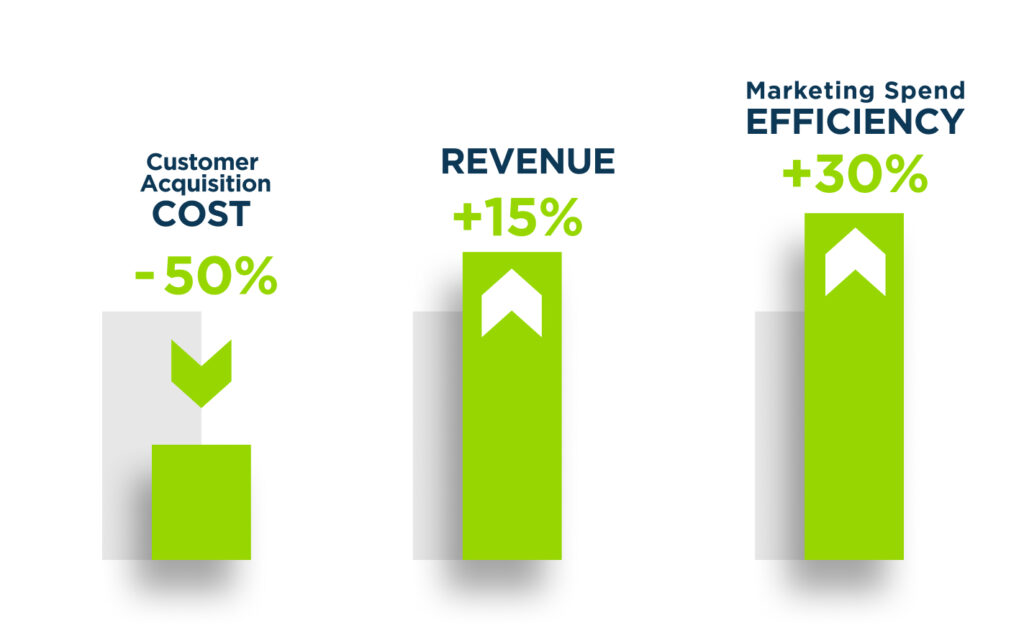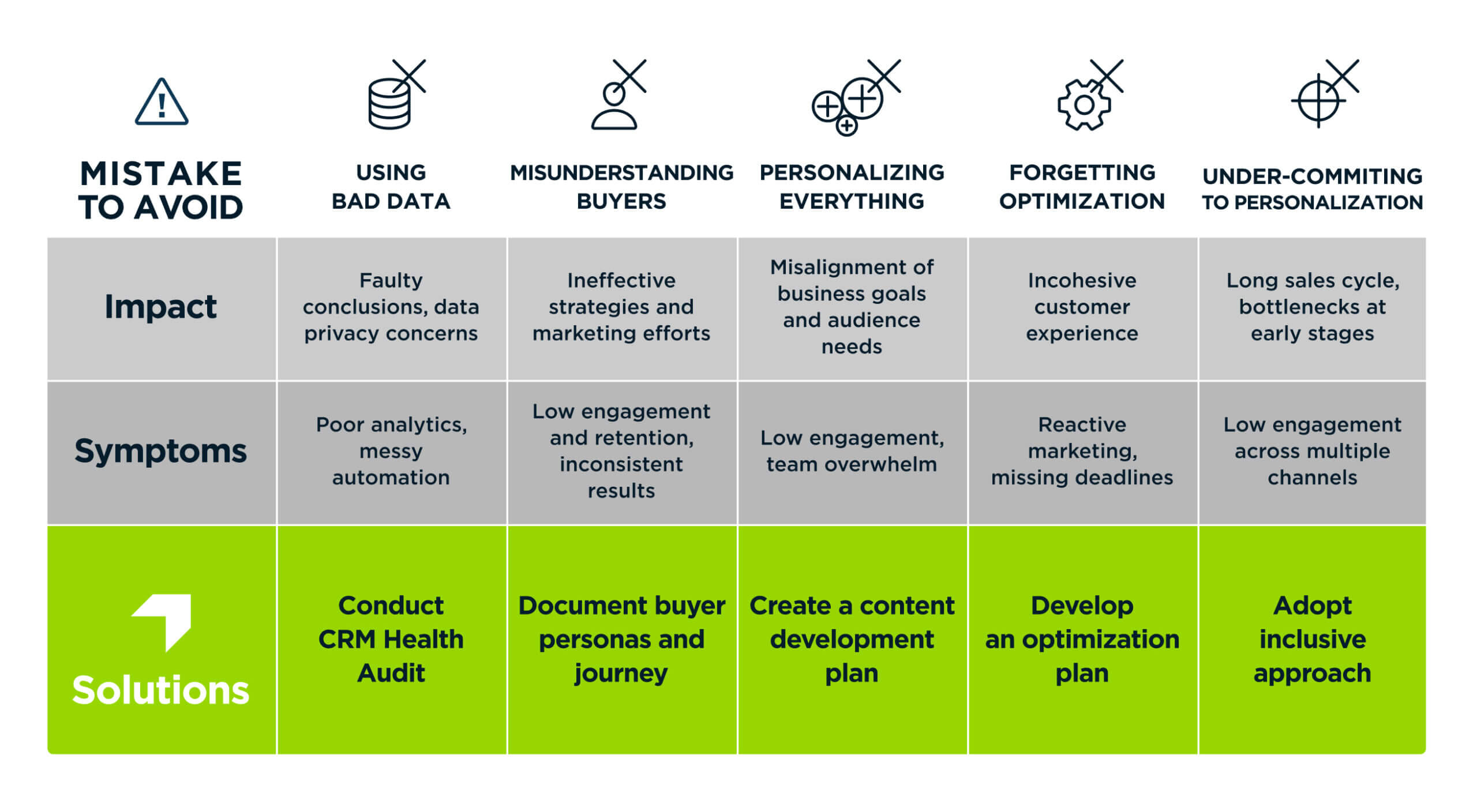Personalized content is considered one of the most effective tactics to optimize marketing automation. It is also considered one of the most difficult to execute. Many of your portfolio companies may be using marketing automation, and delivering personalized content. But are they doing it right?
When a portfolio company is lagging behind your growth hypothesis, one lever to pull is marketing effectiveness at each stage of the marketing funnel. Marketing automation and personalized messaging help portfolio marketers achieve more with the same resources. This is done by increasing conversion rates of the volume of work being performed today, with the benefits of marketing automation providing exponential returns on investment. This helps to build trust, nurture relationships, and drive business growth.
It isn’t breaking news that the impact of personalization on marketing performance is a positive one. According to McKinsey, “Personalization can reduce acquisition costs by as much as 50 percent, lift revenues by 5 to 15 percent, and increase the efficiency of marketing spend by 10 to 30 percent.”

There are five common mistakes that marketing teams make when implementing or using automation to deliver personalized content:
- Using incomplete or bad data
- Misunderstanding your buyers and their journey
- Creating broad content for everyone, everywhere, all at once
- Forgetting process optimization
- Committing only to surface personalization
In this article, we’ll examine the impact, symptoms, and solutions of these common mistakes.
Mistake 1: Using incomplete or bad data
In the digital age, data is at the core of every business, organization, and decision-making process. Good data is essential for accurate analysis, informed decision-making, and achieving desired outcomes. Conversely, bad data can lead to faulty conclusions, ineffective strategies, and potential harm.
It’s common to hear from clients that they need better reporting and analytics. Once we dig in, we see that the customer relationship management (CRM) software has many properties that are not being used, are outdated, incomplete, and unformatted. You can’t have good reporting and analytics, nor can you create personalized messaging or implement automation. If your portcos are strugglig with meaningful personalization, then incomplete or bad data may be the culprit.
The identification, collection, and management of appropriate data is more important than ever. Your RevOps teams and CRM managers should document best practices, implement SOPs, set forced property formatting, and build dashboards to keep teams accountable for the quality of data they are inputting. Setting stage gates and required fields throughout the buyer’s journey is also a simple way to ensure the necessary information is being input.
While data is a valuable tool for marketers, collecting too much data can lead to information overload, inefficiency, privacy concerns, and inaccurate insights. It’s important to strike a balance between collecting enough data to inform your strategies and not overloading with too much information. When a strong foundation of clean, usable data is consistently being used, then expand into the “nice to haves” or “ideal” data collection to support the “nitty gritty” content development process.
The benefits of marketing automation will only start to provide lift when they can accurately assess the needs of your customers. By leveraging good data, marketers can create personalized experiences that resonate with customers, drive better engagement and conversion rates, and ultimately achieve their marketing goals.
Mistake 2: Misunderstanding your buyers and their journey
Knowing who your customers are is critical. But you also need to understand your customers so that you can effectively develop and deliver content that speaks directly to them and solves their unique problems. Equally important is to understand your buyer journey process. At each stage of your buyer journey, your customer will experience different emotions and perceptions as they interact with your brand. Understanding the buyer persona and buyer journey allows marketers to deliver targeted, personalized content that is relevant and timely to the needs and preferences of buyers at each stage. This ensures that the right message reaches the right buyer at the right time, increasing the chances of engagement and conversion.
Some of the most common complaints we hear from clients are that they have poor lead generation and conversion rates. Looking a little deeper, we also see they experience low customer engagement and retention, limited market research or feedback collection, and inconsistent campaign results. All are indicators that your marketing team may not appropriately align your product or services with the correct persona and where they are in the buyer journey. That is to say that they are targeting the wrong audience or their messaging doesn’t resonate with the target audience.
Identifying and documenting buyer personas is a crucial first step in creating a more personalized marketing strategy. Leverage individuals with expertise from various functional areas to complete the task. This usually involves a combination of research, data analysis, and customer insights. Based on the collected information, the team should create detailed profiles that represent different segments of the target audience. Each persona should include information such as demographics, goals, challenges, preferences, decision-making criteria, and typical objections.
Well-understood buyer personas and a defined buyer journey help marketers streamline and optimize their automated marketing efforts. By segmenting audiences based on persona and buyer journey stage, your marketing team can create corresponding automation to deliver targeted messaging. Content delivery automation that aligns with your personas and where they are in the buyer’s journey allows your marketing team to scale their personalized marketing efforts effectively.
Mistake 3: Developing broad content for everyone, everywhere, all at once
Automation enables you to deliver personalized content at scale. How that content is developed requires strategic thought and a clear, documented plan. A well-structured and thoughtful content development plan ensures that personalization is integrated throughout the content creation process, enabling you to engage your audience on a deeper level and deliver tailored experiences that drive better engagement, conversion, and customer satisfaction.
A bad content strategy can manifest itself through various symptoms that indicate its ineffectiveness or lack of alignment with business goals and audience needs. What we may see is a general lack of engagement throughout multiple channels, high bounce rates, inconsistent or sporadic publishing, undefined or vague target audience (see Mistake 2). The marketing team will likely be failing to meet their key performance indicators (KPIs) and business objectives. If your marketing team is indicating that they don’t have the resources to create the necessary content, a bad content strategy is likely the source.
The content development plan should align with customer segmentation and start with the largest or less specific segments first. Accurate segmentation will enable your marketing team to develop an actionable content strategy and reduce pressure on the team by focusing on quality content for your most valuable personas. The “keep it simple” and “do more with less” thought principles are relevant here. Focus on quality over quantity, repurpose existing content to use in different formats or channels and develop content templates that allow for flexibility while maintaining consistency and brand voice.
Personalization and automation can lead to higher returns on investment (ROI) for your content marketing efforts. By delivering personalized content that addresses specific customer needs, you can increase customer satisfaction, loyalty, and, ultimately, conversions. Automation streamlines the process, allowing you to maximize the impact of your content across a larger audience without significantly increasing your resource requirements.
Mistake 4: Forgetting process optimization
Optimized processes enable marketers to scale their personalized marketing efforts efficiently. As your customer base grows, the demand (depth and breadth) for personalized content will also increase. Optimized processes ensure the quality of personalized content so prospects and customers have a cohesive experience across various touch points. This helps reinforce your brand’s messaging and positioning, leading to a more coherent and memorable customer experience.
Often clients will tell us they have adopted a personalized marketing strategy with supporting automation, but they are still experiencing bottlenecks and are struggling to find the resources to keep things running smoothly. Additionally, we may discover that the teams are siloed and not collaborating, that marketing is being reactive instead of proactive, and they are missing deadlines and failing to adapt to trends or a changing environment. All of these are indicators that the marketing team has not continued to optimize their processes and automation.
Process optimization is an ongoing process. The first step is to ensure that your marketing and campaign strategies are aligned with customer needs and preferences and have clear goals, expectations, and definitions of success. Then, document processes and standard operating procedures (SOPs) to ensure that the marketing team is consistently analyzing data to pull out actionable insights. Continuous improvement means continuous monitoring, measuring, and iterating upon workflows, data collection methods, and content. Embracing a culture of continuous improvement will encourage creativity and innovation, collaboration with cross-functional teams, and staying updated with industry trends.
Optimized processes enable marketers to be agile and adaptable in delivering personalized marketing content. In a fast-paced and ever-changing economic landscape, it is crucial that your marketing teams are enabled to respond quickly to changing market trends, customer behavior, and new opportunities. Being able to quickly update campaigns and content based on real-time data and insights could mean you stay ahead of or fall behind your competitors.
Mistake 5: Committing only to surface personalization
Surface personalization aims to create a sense of individualized communication by incorporating basic customer information. However, it does not delve deep into understanding customer preferences, motivations, or specific needs. It relies on readily available data points and may lack the level of personalization required to resonate with customers on a deeper level.
Generally, when we see poor engagement across channels, low clicks, and conversions, it is because the marketing team has subscribed to a generic, one-size-fits-all message that lacks personalization beyond basic demographic details such as name or location. The content performs poorly because it feels mass-produced and doesn’t address specific customer needs or interests.
It is crucial for marketing teams to strike a balance between personalization and broader targeting. They should gather and analyze data to understand customer segments more comprehensively, identify commonalities and differences, and tailor personalized experiences accordingly. By adopting a more inclusive approach to personalization, marketing teams can better address diverse customer needs, improve targeting accuracy, and drive better overall results.
Now, sending “personalized” marketing messages is no longer just addressing the customer by name. Personalization at the next level involves sharing content before they request it and as they need it. This guides them through the funnel more effectively and efficiently, improving customer engagement with every transaction they choose to complete.
Do you know where your portcos are?
Don’t wait until it’s too late in your holding period or exit plan to begin leveraging your portco’s marketing team. Marketing effectiveness and personalization through automation can significantly impact the success of a struggling portfolio company. To optimize your porco marketing team, understand where they are, how they are performing, where opportunities exist, and then how to create an actionable plan to execute.
Optimized automation enables efficient scaling of personalized marketing efforts, ultimately delivering a consistent and memorable customer experience that drives business growth. Marketers can help you unlock ROI potential leading to optimal valuation multiples.
In summary, optimize your portfolio company’s valuation by fully understanding how your portco’s marketing teams are performing. Cortado’s Go-to-Market Assessment can give you a full diagnosis. We can identify opportunities for optimization and form a strategy to help you get the most out of your marketing team. Be proactive, and schedule a discovery call with a Go-to-Market expert today.




